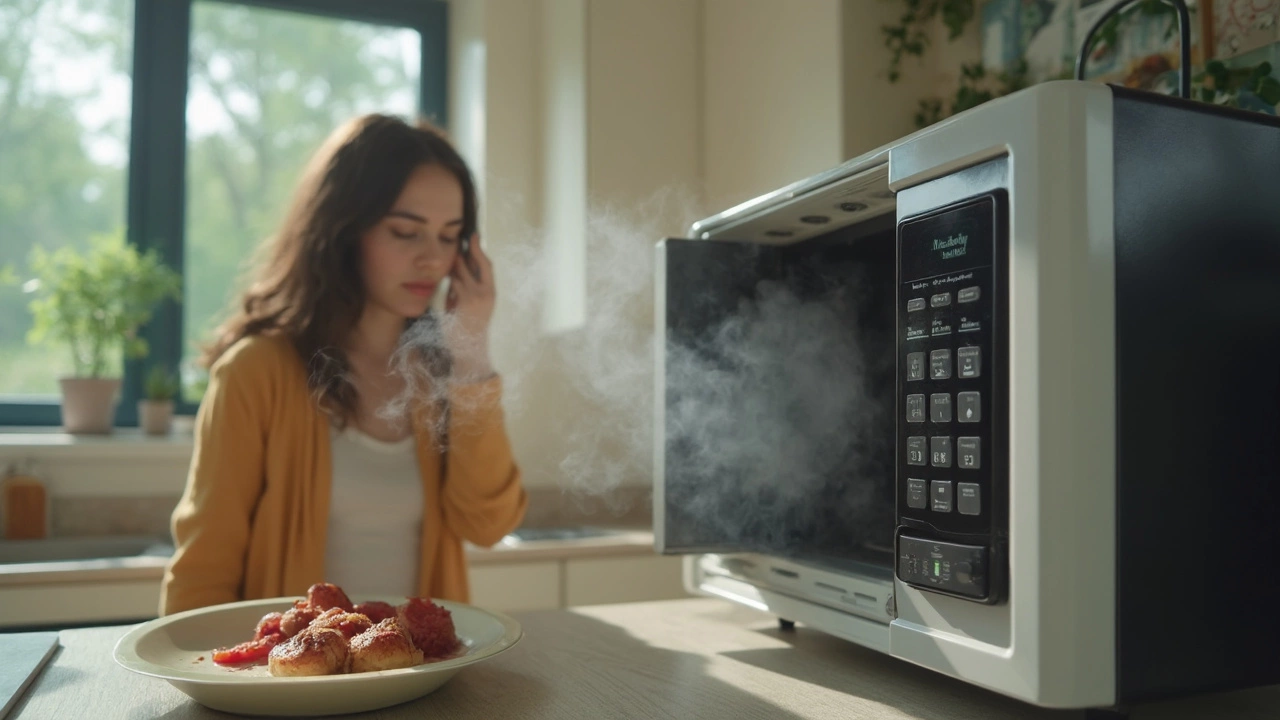Ever hit 'start' on your microwave and watched your food come out just as cold as it went in? You’re probably dealing with a classic magnetron problem. The magnetron is the heart of your microwave—it’s the bit that blasts those magic microwaves to actually cook your food. When it goes bad, reheating pizza or popping popcorn suddenly turns into a headache.
It’s not just about cold dinners. A dying magnetron can give off weird noises, strange smells, or even trip your circuit breaker. Not sure what to look out for? Most folks spot a drop in heating power first, but there are other clues if you know where to look. If you catch the symptoms early, you can avoid wasting time and money on guessing games.
- What Is a Magnetron and Why Does It Matter?
- Bad Magnetron Symptoms: What You’ll See, Hear, and Smell
- Quick DIY Checks Before You Panic
- When to Call It Quits and Get Pro Help
What Is a Magnetron and Why Does It Matter?
If you’ve ever wondered why microwaves cook food so fast, it all comes down to the magnetron. This little metal tube is the powerhouse inside every microwave oven. It takes electricity and turns it into the microwaves that bounce around and heat up your leftovers or popcorn. Without it, your microwave is basically just a fancy storage cabinet.
The magnetron works by pushing electrons through a magnetic field, which makes them zip around at crazy speeds. This action spits out energy waves at the perfect frequency to excite water molecules in food. The result? Your dinner heats up from the inside out. This is why microwaves are way faster than regular ovens.
Here’s a quick look at how important the magnetron is for a working microwave:
- No magnetron, no heat. If this part fails, your food never cooks.
- It runs on pretty high voltage, which is why repairs are risky if you don't know what you’re doing.
- It’s usually the priciest part inside most models—sometimes half the cost of a new machine.
Just to give you an idea, a typical household microwave’s magnetron shoots out between 600 and 1200 watts of power. That’s what gives you hot coffee in less than a minute. Commercial models can go even higher. Here’s a quick wattage comparison for different microwave types:
| Microwave Type | Typical Magnetron Power Output (Watts) |
|---|---|
| Compact/Small | 600-800 |
| Standard/Home | 900-1200 |
| Commercial | 1200+ |
In short, when talking about microwave repair, nothing matters more than the magnetron. That’s why figuring out if it's gone bad should always be step one when your microwave stops working like it should.
Bad Magnetron Symptoms: What You’ll See, Hear, and Smell
If your microwave suddenly stops doing its job, there's a decent chance the magnetron is to blame. First thing you’ll likely notice? Food comes out cold or only slightly warm, even after running a full cycle. The microwave still spins and the lights are on, but the actual cooking power is missing.
You might also hear odd noises. A healthy magnetron usually hums quietly in the background. If yours is failing, you could catch strange buzzing, clicking, or even a harsh growling sound from inside the microwave. Engineers report that a high-pitched squeal is another giveaway. Don’t ignore these sounds—they’re not normal and usually mean trouble brewing.
Another easy giveaway is the smell. A burnt or electrical smell, sometimes like melting plastic, is a big red flag. The magnetron can overheat or short out, causing internal parts or wires to burn. If the smell happens as soon as you start it, stop immediately and unplug it—the risk of fire is real.
Visually, the microwave may look fine at first. But watch for these signs:
- Food never gets hot, just stays cold or lukewarm
- The timer counts down, but there’s no steam or heat inside
- Unusual noises (buzzing, grinding, or rattling)
- Acrid or burning smell when running
- Circuit breaker trips after a few seconds of operation
Just so you know it’s not rare—according to a 2023 survey of home appliance repair shops, magnetron failure is in the top three most common microwave issues right behind faulty door switches and blown fuses.
The key thing: if the light works but your food stays stone cold and any of the above signs show up, your microwave not heating problem probably goes straight back to a bad magnetron.

Quick DIY Checks Before You Panic
Before you call in a pro or start shopping for a new microwave, there are a few simple things you can do to help confirm if the magnetron is the reason your microwave isn’t heating. Most tools you’ll need? Your eyes, ears, and nose. But don’t go unscrewing the microwave just yet—some issues are easy to spot from the outside.
- Double check the power: Unplug your microwave for 30 seconds, then plug it back in. Sometimes the control board just needs a reset. Simple, but it’s worth trying.
- Test with a cup of water: Place a microwave-safe mug with tap water in the center and run it on high for one minute. If the water comes out stone-cold, that’s a big red flag the magnetron isn’t doing its job.
- Listen for odd sounds: A healthy microwave hums quietly. If yours makes loud buzzing, clicking, or rattling noises—especially right after you hit start—that’s a classic sign the magnetron is fried.
- Sniff for burning smells: A weird, electrical burning smell (not just burnt popcorn) during use often points straight to a failing magnetron. Don’t keep using it if you notice this.
- Check for error codes: Newer microwaves might show a code like "F6" or "F7" on the display when the magnetron or control circuit has issues. If you see one, grab your manual or look up your model online.
Here’s a quick table to match symptoms with possible causes:
| Symptom | Most Likely Culprit |
|---|---|
| No heat, but turntable runs | Magnetron failure |
| Loud buzzing or clicking | Magnetron or high voltage diode |
| Burning electrical smell | Magnetron overheating |
| Error code on display | Magnetron/control board issue |
One thing you shouldn’t do? Try to open up the case to poke around inside unless you know what you’re doing. Even unplugged, a microwave’s capacitor can deliver a deadly shock. If these tests point dangerously close to a magnetron problem, you’re better off calling an expert—unless you really know your way around high-voltage parts.
When to Call It Quits and Get Pro Help
If you’ve gone down the checklist and your microwave still isn’t heating, makes weird noises, or smells funky, there’s a good chance the magnetron is shot. This isn’t one of those fixes you can easily pull off with a screwdriver and YouTube video. Magnetrons run at high voltage—even after the microwave is unplugged. Messing with them can zap you hard. In fact, appliance techs use special discharge tools because the capacitor can hold a dangerous charge for days.
So, when should you wave the white flag? Here’s when it’s time to skip DIY and call a pro:
- Microwave not heating: If the turntable spins but you get cold food, the magnetron’s a likely culprit.
- Bizarre humming or buzzing: A healthy microwave makes a low, consistent hum. A fried magnetron sounds rough, often louder or uneven.
- Burning smell or visible smoke: Don’t ignore this. If the inside smells like burning plastic or you see sparks, the magnetron may be breaking down.
- Repeated tripped circuit breaker: If plugging in the microwave keeps blowing your breaker, stop using it—repair techs say this points to a fail in the high-voltage circuit, often the magnetron.
You might wonder about cost. On average, replacing a magnetron runs from $100 to $200 just for the part, not counting labor. If your microwave is cheap or more than five years old, repair probably isn’t worth it. You’re usually better off replacing the whole thing. Here’s a quick look at typical repair costs:
| Repair Type | Estimated Cost |
|---|---|
| Magnetron Replacement | $150 - $300 |
| New Microwave | $70 - $500 |
Bottom line: Unless you have electrical skills and the right tools, let an appliance pro handle microwave repair. High voltage parts are no joke. If the unit’s old, compare the repair price to a brand-new microwave—you’ll often save money and headaches with an upgrade.


